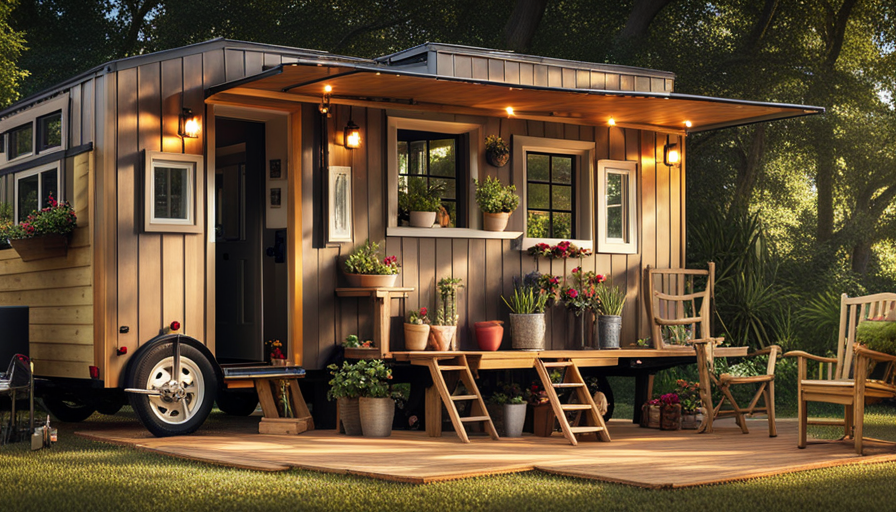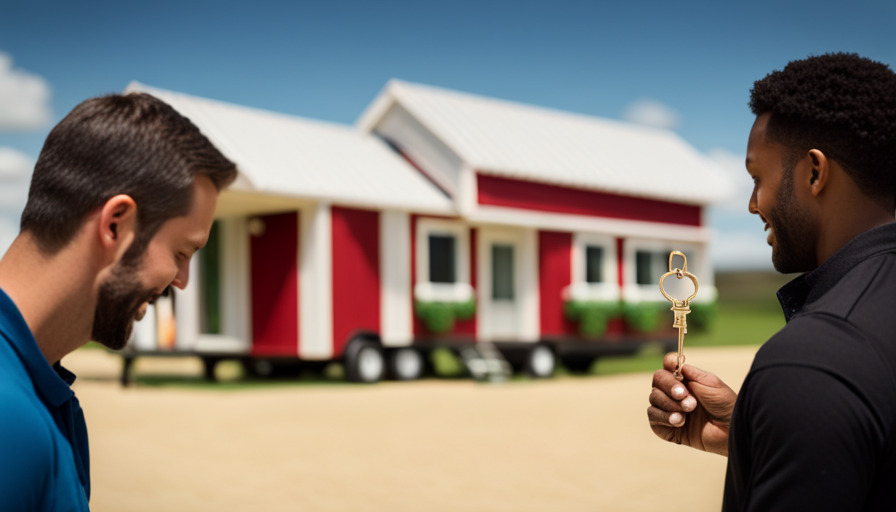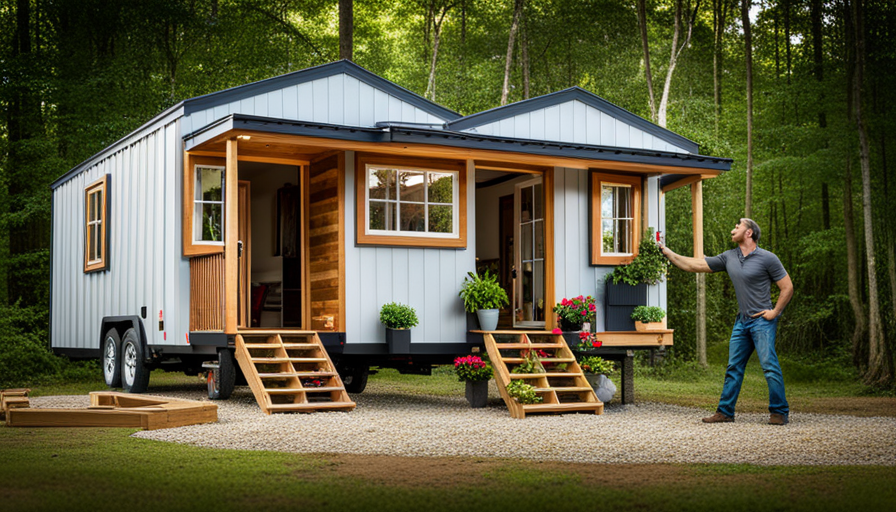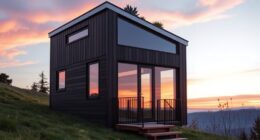Designing your compact mobile home is akin to embarking on a grand adventure. It involves creativity, resourcefulness, and a touch of wanderlust.
Just imagine, crafting your own compact abode on wheels, a nomadic sanctuary that can take you anywhere your heart desires. But here’s the best part: you can achieve this dream on a tight budget. Yes, with a little ingenuity and some careful planning, you can build a tiny house on a trailer without breaking the bank.
In this article, I will guide you through the step-by-step process of constructing your very own tiny home, highlighting cost-effective methods and clever tricks along the way. From finding the perfect trailer to finalizing the plumbing and electrical systems, we will cover it all.
So, let’s dive in and turn your vision of a cheap, yet charming, tiny house on wheels into a reality. Get ready to unleash your inner architect and embrace the freedom of tiny living.
Key Takeaways
- Building a tiny house on a trailer requires creativity, resourcefulness, and careful planning.
- Consider factors such as budget, design considerations, and local building codes when building a tiny house on a trailer.
- Maximize space and incorporate storage through layout and interior design choices.
- Use affordable materials and select the right tools for an efficient building experience.
Determine Your Budget and Design
Now it’s time to figure out how much money you can save and what kind of tiny house design will make your dreams come true. Determining your budget is the first step in building a tiny house on a trailer cheap.
Take a look at your finances and determine how much you can allocate towards this project. Consider your income, expenses, and savings goals. It’s important to be realistic and set a budget that you can stick to.
Next, consider the design of your tiny house. Think about your needs, wants, and lifestyle. Are you looking for a simple and minimalist design? Or do you need more space and amenities? Consider factors such as the number of rooms, the size of the kitchen and bathroom, and the overall layout. Additionally, think about any specific design considerations such as energy efficiency, storage solutions, or mobility.
Once you have determined your budget and design considerations, you can move on to finding a suitable trailer. This is an important step as the trailer will serve as the foundation for your tiny house. Look for a trailer that is the right size and weight capacity for your design. Consider factors such as durability, towing capabilities, and any specific requirements for your area.
With your budget and design in mind, find a trailer that meets your needs and will allow you to build your dream tiny house on a trailer cheap.
Find a Suitable Trailer
When searching for a suitable trailer for my tiny house, I needed to research different options available. It was important for me to consider the size, weight capacity, and durability of the trailers I came across.
By thoroughly examining these factors, I was able to make an informed decision on which trailer would best suit my needs and ensure the safety and stability of my tiny house.
Research Different Trailer Options
To begin your research on different trailer options, you may want to consider exploring various manufacturers and models that offer affordable yet reliable choices for building a tiny house on wheels.
-
When comparing prices, it’s important to look for trailers that fit within your budget while still meeting your needs. Some manufacturers offer budget-friendly options without compromising on quality.
-
Look for trailers that are specifically designed for tiny house construction. These trailers often have reinforced frames and special features to accommodate the unique requirements of a tiny house build.
When considering size, weight capacity, and durability, keep in mind that these factors will impact the overall design and functionality of your tiny house. It’s crucial to choose a trailer that can support the weight of your structure and provide enough space for your desired layout. Additionally, durability is essential to ensure the longevity of your tiny house. By carefully researching different trailer options and comparing prices, you can find the perfect fit for your tiny house project.
Consider Size, Weight Capacity, and Durability
Considering the incredible strength of a tiny house trailer, it’s crucial to select a size, weight capacity, and durability that will ensure the longevity and functionality of your dream home on wheels.
When choosing a trailer, consider the weight distribution of your tiny house. It’s important to distribute the weight evenly to avoid any structural issues during transportation.
Additionally, think about the weight capacity of the trailer and make sure it can handle the load of your tiny house, including all the furniture and appliances.
Durability is another key factor to consider. Look for trailers made from high-quality materials that can withstand various weather conditions and road vibrations. Regular trailer maintenance is also essential to keep it in optimal condition.
Now, let’s delve into the next section about obtaining permits and legal requirements for your tiny house on wheels.
Obtain Permits and Legal Requirements
Before starting the construction process, it’s essential to research and understand the local building codes and zoning regulations. This will ensure that your tiny house complies with the necessary requirements and avoids any legal issues.
Once familiar with the regulations, I’ll apply for the necessary permits and licenses to proceed with the construction, ensuring that all legal requirements are met before starting the project.
Research Local Building Codes and Zoning Regulations
Firstly, it’s crucial to familiarize yourself with the local building codes and zoning regulations in order to ensure a smooth and legal construction process for your affordable tiny house on a trailer. Researching local building codes and zoning regulations allows you to understand the legal restrictions and requirements that apply to your project. By exploring alternative housing options, you can determine if a tiny house on a trailer is permitted and what specific regulations may apply. To emphasize the importance of this research, consider the following table:
| Building Codes | Zoning Regulations |
|---|---|
| Minimum square footage requirements | Residential versus commercial zones |
| Structural and safety standards | Setbacks and lot coverage |
| Plumbing and electrical requirements | Height restrictions |
Understanding these regulations will guide your design and construction choices. Once you have thoroughly researched the local codes and zoning regulations, you can confidently proceed to apply for necessary permits and licenses.
Apply for Necessary Permits and Licenses
To ensure a smooth and legal construction process, it’s crucial to apply for the necessary permits and licenses for your affordable tiny home on wheels. Here are the four steps to follow:
-
Research local requirements: Each area may have different regulations, so it’s important to thoroughly understand the specific permits and licenses needed for your tiny house on a trailer.
-
Building permits: Typically, you’ll need a building permit for any structure, including a tiny house. This permit ensures that your construction meets safety standards and zoning requirements.
-
Electrical and plumbing permits: If you plan to have electricity or plumbing in your tiny house, you’ll need additional permits for these systems. Hiring a licensed professional can help ensure compliance with codes.
-
Zoning and land use permits: Depending on your location, you may need permits related to zoning and land use regulations. This will determine if you can legally park or live in your tiny house on a trailer.
By obtaining the necessary permits and licenses, you can enjoy the benefits of living in a tiny house, such as reduced environmental impact and lower costs. Once these steps are complete, you can move on to planning the layout and interior design of your compact home.
Plan the Layout and Interior Design
Additionally, carefully consider the layout and interior design of your tiny house on a trailer to achieve a cost-effective build. Maximizing space and incorporating storage are key factors in creating an efficient and functional living area. By strategically planning the layout, you can make the most of every square inch and avoid wasted space.
To help you visualize the possibilities, here is a 2 column and 5 row table showcasing different layout options:
| Layout Option | Benefits |
|---|---|
| Open Concept | Creates a sense of spaciousness |
| Loft Bedroom | Maximizes floor space |
| Murphy Bed | Provides flexibility in room usage |
| Built-in Shelves | Utilizes vertical space for storage |
| Foldable Furniture | Allows for multi-purpose use of furniture |
By incorporating these design elements, you can optimize your tiny house’s layout to suit your specific needs while keeping costs low. Remember to prioritize functionality over aesthetics to make the most of your limited space.
Next, in the section about gathering materials and tools, you will learn how to source affordable materials and select the right tools for the construction process. This will ensure a smooth and efficient building experience.
Gather Materials and Tools
Now, you need to gather the necessary materials and tools to bring your tiny house on a trailer to life, making your building journey exciting and fulfilling.
Here’s a list of materials you’ll need:
-
Lumber: Purchase high-quality lumber for the frame, walls, and roof of your tiny house. Opt for treated lumber for added durability and resistance to rot and pests.
-
Insulation: Choose insulation materials that are suitable for your climate. Fiberglass batts or rigid foam insulation are commonly used in tiny house construction.
-
Exterior siding: Consider using durable and low-maintenance siding options such as vinyl, fiber cement, or metal. These materials will protect your tiny house from the elements.
In addition to these materials, you’ll need a set of essential tools to complete your project efficiently:
-
Power tools: Invest in a circular saw, drill, and a good quality nail gun. These power tools will make the construction process much faster and easier.
-
Hand tools: Have a set of basic hand tools like a hammer, tape measure, level, screwdriver, and utility knife. These tools will be helpful for precise measurements and minor adjustments.
-
Safety equipment: Don’t forget to prioritize safety. Wear protective gear like gloves, safety glasses, and a dust mask when handling materials and using power tools.
With all the necessary materials and tools at hand, you’re now ready to move on to the next section and start building the foundation and frame of your tiny house.
Build the Foundation and Frame
Once you have gathered all the necessary materials and tools, it’s time to start constructing the foundation and frame of your tiny house. Building the foundation and frame is a crucial step in the construction process as it provides stability and structural support for your tiny house on a trailer. To ensure a sturdy foundation, you can use techniques such as using pressure-treated wood for the base and reinforcing it with steel brackets or hurricane ties. This will help prevent any shifting or movement during transportation.
When it comes to building the frame, cost-saving tips can be implemented without compromising on quality. One technique is to use standard-sized lumber instead of custom-cut pieces, as they are more affordable and readily available. Additionally, opting for a simple design with fewer corners and angles will reduce the complexity of construction and save both time and money.
To give you a visual representation, here’s a table showcasing the materials and approximate costs for the foundation and frame construction:
| Materials | Approximate Cost |
|---|---|
| Pressure-treated wood | $300-$500 |
| Steel brackets/hurricane ties | $50-$100 |
| Standard-sized lumber | $400-$600 |
Once the foundation and frame are complete, you can move on to the next step of installing plumbing and electrical systems. This will ensure that your tiny house is equipped with the necessary utilities for comfortable living.
Install Plumbing and Electrical Systems
Don’t delay, dive into the installation of plumbing and electrical systems in your tiny abode to ensure a seamless and sophisticated living space.
When it comes to setting up the plumbing layout, careful planning is essential. Begin by determining the location of the bathroom and kitchen, as this will dictate the placement of water supply lines and drain pipes. Consider the size of your tiny house and the number of fixtures you plan to install. A well-thought-out plumbing design will maximize space efficiency and functionality.
Next, it’s time to tackle the electrical wiring plan. Start by creating a detailed diagram that outlines the location of outlets, switches, and lighting fixtures. Take into account the power requirements of your appliances and devices to ensure that the electrical system can handle the load. Safely route the wiring through walls and ceilings, keeping in mind the necessary safety precautions.
Once the plumbing and electrical systems are installed, you can move on to the next step of insulating and weatherproofing the house. This crucial stage will help maintain a comfortable indoor temperature and protect your tiny home from the elements.
With the plumbing and electrical systems in place, it’s time to make your tiny house cozy and energy-efficient.
Insulate and Weatherproof the House
When insulating and weatherproofing my tiny house, I made sure to choose the right insulation materials for maximum efficiency.nnI carefully sealed all gaps and cracks to prevent any heat loss.nnBy using high-quality insulation and properly sealing the house, I was able to create a comfortable and energy-efficient living space.
Choose the Right Insulation Materials
To maximize cost efficiency while ensuring adequate insulation, it’s crucial to carefully select the right materials for insulating a tiny house built on a trailer. When considering insulation options, it’s important to choose cost-effective materials that provide optimal thermal performance.
Here are three insulation materials that can help create an energy-efficient tiny house:
-
Fiberglass insulation: Made from fine glass fibers, fiberglass insulation is a popular choice due to its affordability and effectiveness in reducing heat transfer.
-
Spray foam insulation: This type of insulation expands to fill gaps and provides excellent air sealing, preventing heat loss and reducing energy consumption.
-
Polyiso insulation: With its high R-value and minimal thickness, polyiso insulation is perfect for tiny houses as it provides superior thermal resistance while occupying less space.
By carefully selecting these insulation materials, you can create a well-insulated tiny house that minimizes heat loss and maximizes energy efficiency.
Moving on to the next section, it’s important to seal gaps and cracks to prevent any potential heat loss.
Seal Gaps and Cracks to Prevent Heat Loss
Make sure you seal gaps and cracks tightly to keep the warmth inside and create a cozy, energy-efficient living space. Common insulation methods include using spray foam, fiberglass batts, or rigid foam boards. Spray foam is a popular choice as it can expand and fill any gaps, providing an airtight seal. Fiberglass batts are easy to install and are cost-effective, but they may not completely seal all gaps. Rigid foam boards offer high insulation value and can be easily cut to fit specific areas. Additionally, consider energy-efficient window options, such as double or triple pane windows with low-emissivity coatings. These windows can reduce heat loss and enhance the overall energy efficiency of your tiny house. By properly sealing gaps and choosing the right insulation materials, you can minimize heat loss and create a comfortable living space. Moving on to the next step, let’s discuss how to finish the interior and exterior of your tiny house.
Finish the Interior and Exterior
To finish the interior and exterior of a tiny house, I’ll need to install the flooring, walls, and ceilings. This involves choosing and laying down appropriate materials for the floors, such as laminate or hardwood.
For the walls and ceilings, I’ll need to insulate and cover them with drywall or paneling to create a clean and finished look.
After completing the interior, I’ll move on to the exterior by painting or staining it.
Finally, I’ll add the finishing touches, such as installing trim and hardware, to complete the overall aesthetic of the tiny house.
Install Flooring, Walls, and Ceilings
Get ready to transform your tiny house on a trailer into a cozy haven by installing the flooring, walls, and ceilings. When it comes to flooring options, there are several choices available that are both affordable and practical. You can opt for vinyl, laminate, or even reclaimed wood for a rustic touch. Consider the durability and maintenance requirements before making a decision. Moving on to the walls, this is where you can get creative with unique designs. From shiplap to geometric patterns, the possibilities are endless. Installing drywall is also a popular choice for a clean and polished look. Finally, don’t forget about the ceilings. You can go for a classic white finish or add texture with exposed beams. Now that the interior is taking shape, it’s time to move on to the next step: paint or stain the exterior and add finishing touches.
Paint or Stain the Exterior and Add Finishing Touches
Once you’ve finished transforming your cozy haven on wheels, it’s time to give the exterior a pop of color or a rich stain, and add those final touches that will make your tiny house truly stand out.
When it comes to choosing the right exterior color options for your tiny house, consider factors such as your personal style, the surrounding environment, and any local regulations. Whether you opt for a bold and vibrant hue or a more subtle and natural tone, make sure to use high-quality paint or stain that’ll withstand the elements.
Additionally, don’t forget to consider DIY exterior decorations to add personality and charm to your tiny house. From hanging plants and outdoor lighting to customized signs and window boxes, the possibilities are endless. These finishing touches will enhance the overall aesthetic appeal of your tiny house.
Now, let’s move on to the next section where we’ll finalize plumbing, electrical, and safety checks.
Finalize Plumbing, Electrical, and Safety Checks
In this section, I’ll discuss the final steps for completing the plumbing, electrical, and safety checks in my tiny house on a trailer.
First, I’ll test and adjust all plumbing fixtures and connections to ensure they’re functioning properly. This includes checking for leaks, adjusting water pressure, and ensuring proper drainage.
Next, I’ll inspect the electrical systems, making sure all wiring is properly installed and connected. I’ll also ensure that safety measures such as circuit breakers and smoke detectors are in place and functioning correctly.
Test and Adjust Plumbing Fixtures and Connections
Check for leaks and make sure all plumbing fixtures and connections are properly sealed; you don’t want any surprises when you turn on the water in your cozy little home.
To test and adjust plumbing fixtures, start by turning on the water supply and checking each fixture for any leaks or drips. If you notice any issues, troubleshoot the plumbing by tightening connections or replacing faulty parts.
It’s essential to ensure that all fixtures, such as sinks, showers, and toilets, are functioning correctly and that water flows smoothly through the pipes. Regular plumbing maintenance and repairs are crucial to prevent costly water damage and maintain the efficiency of your tiny house.
Once you have addressed any plumbing issues, it’s time to inspect electrical systems and ensure safety measures are in place.
Inspect Electrical Systems and Ensure Safety Measures are in Place
Make sure all electrical systems are in proper working order and that safety measures, such as circuit breakers and grounded outlets, are in place to protect your cozy dwelling from any potential hazards.
When inspecting the electrical system, it’s crucial to adhere to electrical safety measures to ensure the safety of your tiny house on a trailer. Here are three important steps to follow:
-
Thoroughly examine all electrical connections and wiring to identify any signs of wear or damage.
-
Test all outlets, switches, and light fixtures to verify they’re working correctly.
-
Check the grounding system to ensure it’s properly installed and functioning as it should.
By following these steps, you can identify any potential electrical issues and address them promptly. It’s essential to prioritize electrical safety to prevent accidents and maintain a secure environment within your tiny house.
Frequently Asked Questions
Can I build a tiny house on a trailer without obtaining any permits or legal requirements?
Building a tiny house on a trailer without obtaining any permits or meeting legal requirements is not advisable. It’s like navigating through a minefield blindfolded.
Tiny house zoning laws and legal implications of building without permits vary by location, and violating them can result in fines, forced removal, or even legal action.
To ensure a smooth and legal process, it’s crucial to familiarize yourself with local regulations and obtain the necessary permits before starting your project.
How long does it typically take to build a tiny house on a trailer?
On average, building a tiny house on a trailer typically takes around 3-6 months, depending on the complexity of the design and the amount of time and resources you can dedicate to the project. It’s important to consider cost considerations such as materials, labor, and any specialized tools or equipment needed. The construction time can also be influenced by factors like weather conditions and the availability of skilled workers.
Are there any restrictions on where I can park my tiny house on a trailer?
Parking regulations and zoning restrictions dictate where you can park your tiny house on a trailer. These regulations vary depending on your location and can determine if you can park on private property, in a designated tiny house community, or as an accessory dwelling unit.
It’s essential to research and understand these rules before embarking on your tiny house journey. Compliance with local regulations ensures a hassle-free and legal parking situation for your tiny house.
What are some common challenges or obstacles people face when building a tiny house on a trailer?
When building a tiny house on a trailer, common challenges often arise due to budget constraints. These challenges can include finding affordable materials and appliances, as well as managing overall costs throughout the construction process.
Additionally, ensuring the structural integrity of the house while keeping costs low can be a struggle. It’s crucial to carefully plan and research cost-effective solutions to overcome these obstacles and successfully build a tiny house on a trailer within budget constraints.
Are there any specific building codes or regulations I need to follow when constructing a tiny house on a trailer?
When constructing a tiny house on a trailer, it’s crucial to adhere to building codes and regulations. These codes and regulations vary depending on your location, so it’s essential to research and understand the specific requirements in your area.
They typically cover aspects such as weight limits, trailer specifications, safety measures, plumbing, electrical systems, and overall structural integrity. Compliance with these codes ensures a safe and legal construction process for your tiny house on a trailer.
Conclusion
In conclusion, building a tiny house on a trailer has been quite the adventure. From determining my budget and design to obtaining permits and legal requirements, every step has been meticulously planned and executed.
Gathering the necessary materials and tools, installing the plumbing and electrical systems, and insulating and weatherproofing the house have all been essential in creating a secure and comfortable living space.
Finally, finishing the interior and exterior, and completing the necessary checks have brought this project to a successful close. Through perseverance and attention to detail, my tiny house on a trailer now stands as a testament to my determination and ingenuity.
Hi, I’m Emma. I’m the Editor in Chief of Tiny House 43, a blog all about tiny houses. While tree houses are often associated with childhood, they can be the perfect adult retreat. They offer a cozy space to relax and unwind, surrounded by nature. And since they’re typically built on stilts or raised platforms, they offer stunning views that traditional homes simply can’t match. If you’re looking for a unique and romantic getaway, a tree house tiny house might just be the perfect option.










